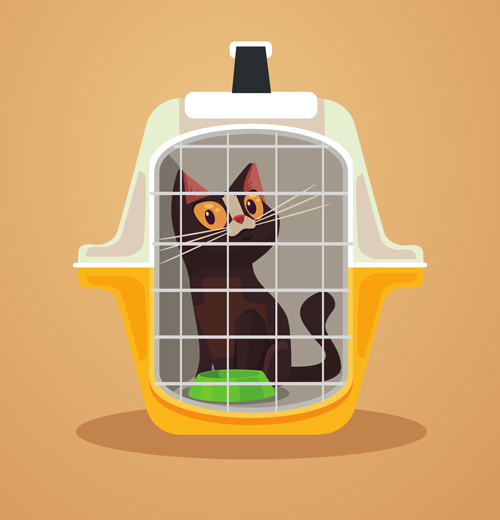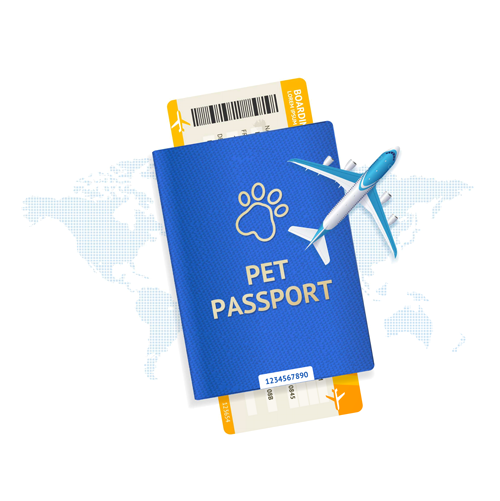Air travel with pets - what do I have to watch out for?

Not all pets are allowed to fly
Most airlines transport pets for an appropriate surcharge. However, there are exceptions. Brachycephalic dogs and cats, i.e. dogs and cats with short noses such as pugs and bulldogs or Persian cats, as well as all breeds classified as fighting dogs, are not transported. Which breeds are affected is decided by the respective airline. Some low-cost airlines such as Ryanair or Easyjet do not take any animals at all except assistance dogs. Eurowings only allows small dogs and cats up to a maximum of eight kilos in hand luggage. It is therefore essential that you clarify in advance whether or not your airline will transport your pet.
Cabin or cargo hold?
If you want to take your pet with you on your journey in the cabin, you must register it with the airline or your travel agency beforehand. Most airlines only allow dogs and cats in the cabin if they do not weigh more than eight kilograms together with the transport container. Rodents are not allowed on board for safety reasons. Check with your airline to see if they have such a rule.


What are the costs for bringing your own pet?
Regardless of whether you are allowed to take your pet into the cabin with you or it has to travel in the hold, there is a charge for taking it with you in any case. The amount of the costs depends not least on the length of the route. On short flights in the cabin, depending on the airline, 25 euros may be enough; for large dogs transported in the hold over long distances, it can be as much as 300 euros. Of course, you have to provide the transport boxes yourself; only very few airlines provide transport containers.
Your pet needs these travel documents
When registering your pet with the airline or travel agency, you will receive a form on the regulations for the carriage of animals, which you must complete and sign on the day of departure. In addition, the airline expects you to take care of the necessary import, export and transit documents for your animal. Depending on the destination country, different entry and quarantine conditions apply. In principle, dogs and cats can only be transported if they have a valid rabies vaccination. Some countries of destination, such as Ireland, Finland and Malta, also require treatment against tapeworms. You can get information about the required vaccinations from the consulate of your destination country.

Within the EU and some other countries, the standard pet passport is sufficient as proof of vaccination status. This passport must be able to be assigned to the animal without any doubt by means of a microchip. The veterinarians enter all vaccinations and their validity in this card. In addition, the breed and age as well as information about the appearance are noted in the pet passport. By the way, the uniform European travel regulations only apply to dogs and cats. For all other pets such as guinea pigs, rabbits and birds, the respective regulations of the destination country apply.
Find out about the required vaccinations as early as possible. For example, the rabies vaccination required for dogs and cats takes three weeks to build up. If you want to re-enter the EU from a non-EU country, you must provide proof of antibodies for rabies for your pet. You can have this test done in advance at your veterinary practice, but not before 30 days after the vaccination. As puppies cannot be vaccinated against rabies until they are twelve weeks old, dogs and cats can only travel from the age of 15 weeks.
Our tip: Check the vaccination status according to the requirements of your destination country as early as possible. Only then will you have enough time before departure to catch up on all the required vaccinations and obtain the corresponding certificates.
If you are already at the vet, have your pet's health certified and create a checklist for the first-aid kit together with him. And in any case, you should take out pet owner liability insurance. Although it is not compulsory, it can save you from high costs if the animal breaks something in the hotel or holiday flat or there are other incidents, especially biting incidents. Take a copy of the insurance policy with you when you travel.

Should the animal really fly with us?
You know your pet best and know what you can and cannot expect of it. It is clear that a journey, especially one in the hold of an aeroplane, means pure stress for the animal. This may not be without psychological consequences. Especially in young dogs, such an experience can cause considerable damage that may not be recoverable. This also applies to fearful dogs. It is less bad for dogs that can fly along in the cabin. They keep contact with their owners and are less stressed for that reason alone.
Airlines try hard to make the flight as comfortable as possible for their animal cargo. Although the background noise cannot be turned off, the transport boxes are not placed among the suitcases and luggage, but in an air-conditioned extra area in the cargo hold.
In addition to the journey, the unfamiliar surroundings and possibly a change of climate also play a decisive role in your dog's well-being. There are hotels where pets are allowed. But is it really so pleasant for your four-legged friend to have to spend hours alone in a cramped hotel room in the summer heat when you can't take him with you to eat or go shopping, for example?
Cats and other small animals and birds should generally only be expected to travel if there is no other option, for example because you are moving house or even moving abroad. Velvet paws need at least four weeks to get used to a new environment, so it makes no sense at all to take your cat with you on a two-week stay. It would have to stay in the hotel room or holiday flat for the entire holiday period, while you might want to lie on the beach or explore the surroundings.
Our tip: If you want to take your pets with you on holiday, choose a direct flight to avoid unnecessary loading stress. And in summer, opt for an early morning or late evening flight so that the pet is not already stressed on the journey to the airport.
What are the alternatives?
If you do not want to or perhaps cannot expect your pet to travel by plane, choose a holiday destination that is accessible by car or train. Most dogs and cats are used to driving in everyday life. Make sure that your pet is adequately secured in the vehicle with a partition grille to the cargo area, a transport container or a leash.
On the train, small, harmless dogs and cats are sometimes even transported free of charge in transport boxes. Large dogs must be kept on a leash and wear a muzzle. In addition, a ticket is required for them in any case. Even with a ticket, dogs and cats are not entitled to a seat. They must be placed in front of your seat or sit or lie there during the journey.

If you are travelling by plane, train or car, you should not feed your pet for twelve hours beforehand. If food has to be given on the way, it should only be small portions. Unlike a flight, you can give your pet a sedative in consultation with the vet so that it sleeps through the journey.
If you do want to spend your holiday in faraway countries and leave your pet at home, you have several options for accommodating your pet. If you can't find family members or friends who can look after the dog, you can turn to a special boarding kennel or private foster home. Both are used to dealing with strange dogs or cats and the animals usually feel very comfortable in the company of their fellow species. Some boarding kennels offer daily walks as well as special care programmes such as agility. However, take a close look at the boarding or foster home beforehand and arrange a trial appointment. Ask for a certificate of competence and make sure that emergency care is taken care of. In most boarding kennels, a valid pet owner's liability insurance is a mandatory requirement for admission.
Another possibility are initiatives organised by animal welfare associations such as "If you take my pet, I'll take your pet". Pet owners take care of each other's animals. Information on this is available from your local animal welfare association or the German Animal Welfare Association.
Cats, small animals and birds can also stay in their homes. It is enough if someone comes by twice a day to look after them. Cats, for example, usually sleep 20 hours a day, so the care remains manageable. For dogs, however, this is not a solution. They need contact with people and are not satisfied with two walks a day and food once. Therefore, they should never be left alone at home.
Conclusion
Today, taking pets on holiday is a matter of course. This also applies to air travel. Most airlines will take pets on the plane under certain conditions. However, this usually only applies to dogs and cats. Small animals, especially rodents, and birds are not allowed on board for safety reasons.
Smaller animals are allowed to fly in the cabin, larger ones must be transported in properly equipped transport boxes in the cargo hold. Not all animals can cope with transport in the hold without problems, even though the airlines make every effort to ensure the welfare of the animals.
No matter to which country the holiday trip goes, a rabies vaccination certificate is required everywhere. Normally, the standard EU pet passport in combination with a microchip is sufficient. Some countries have special entry and quarantine regulations. You can find out what these are in individual cases from the consulate of your destination country.
In some cases it is better to have pets looked after in a boarding or foster home. Cats, small animals and birds can even stay in their familiar surroundings if they are cared for regularly. They generally feel more comfortable at home than when travelling.



